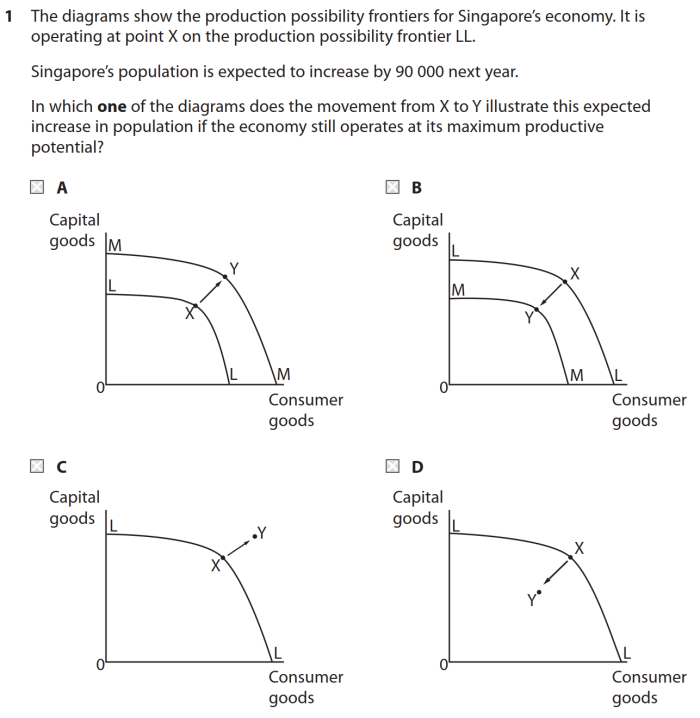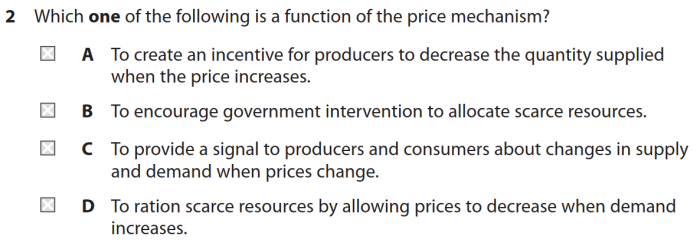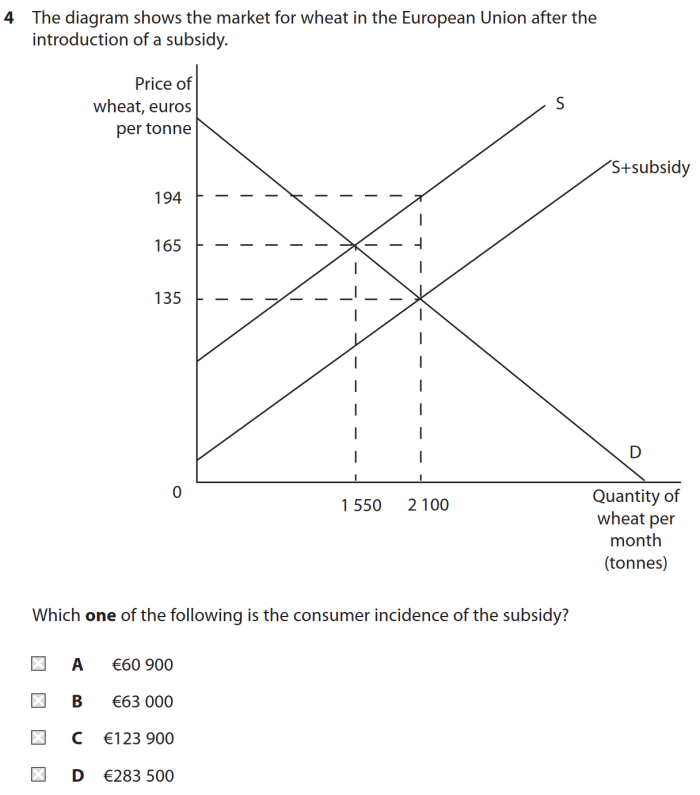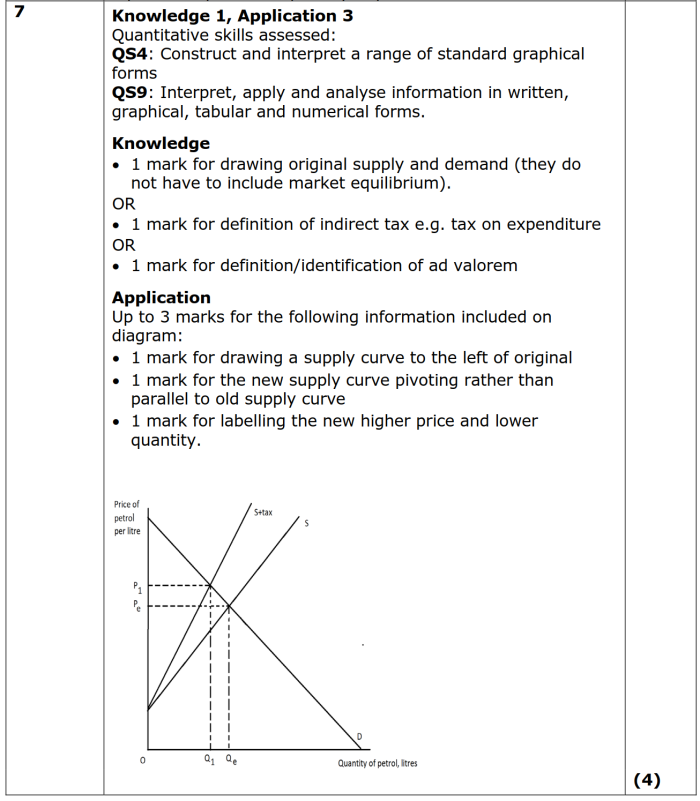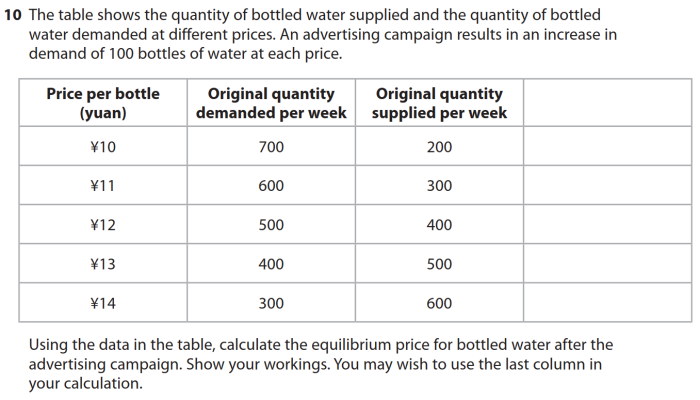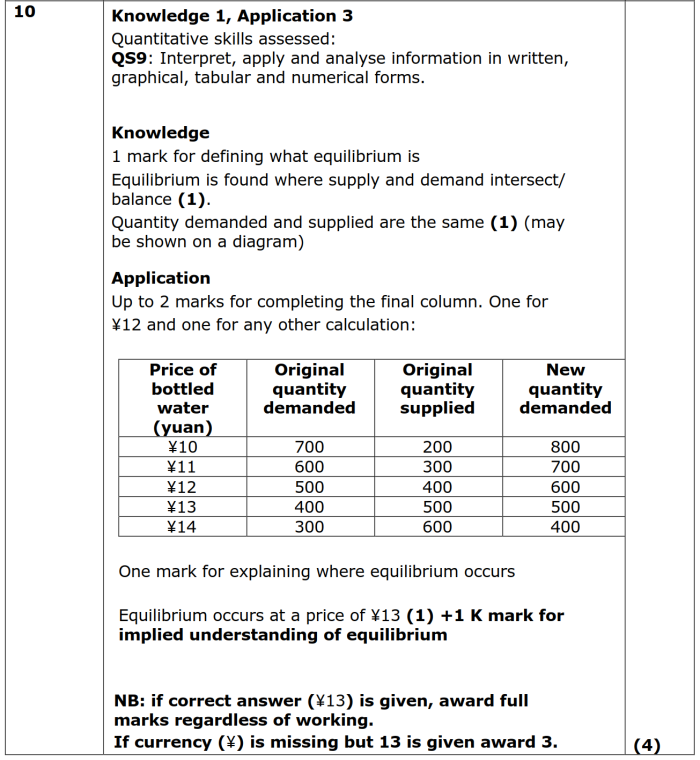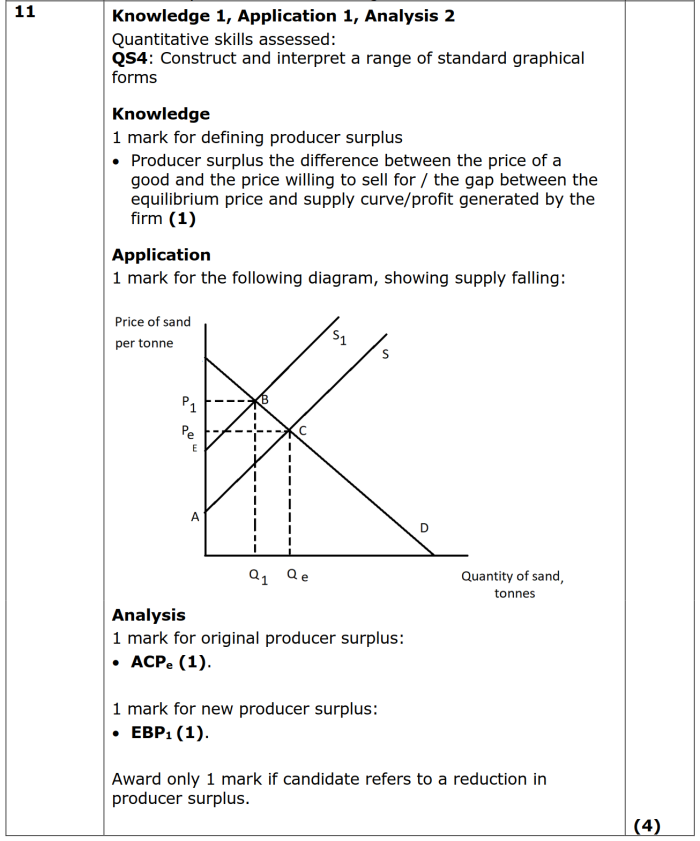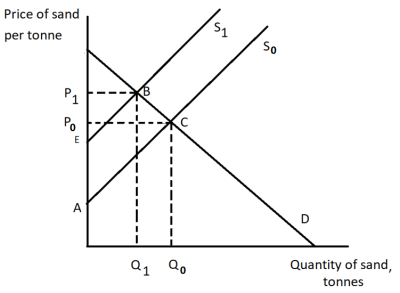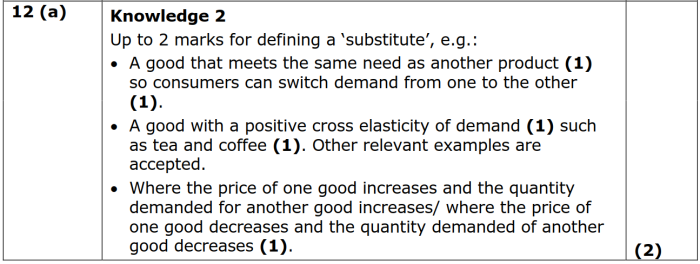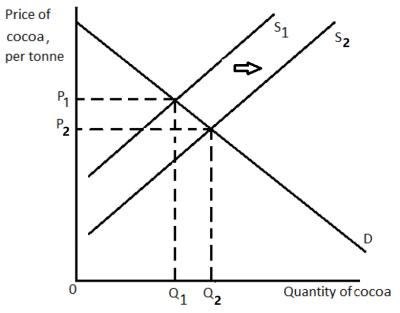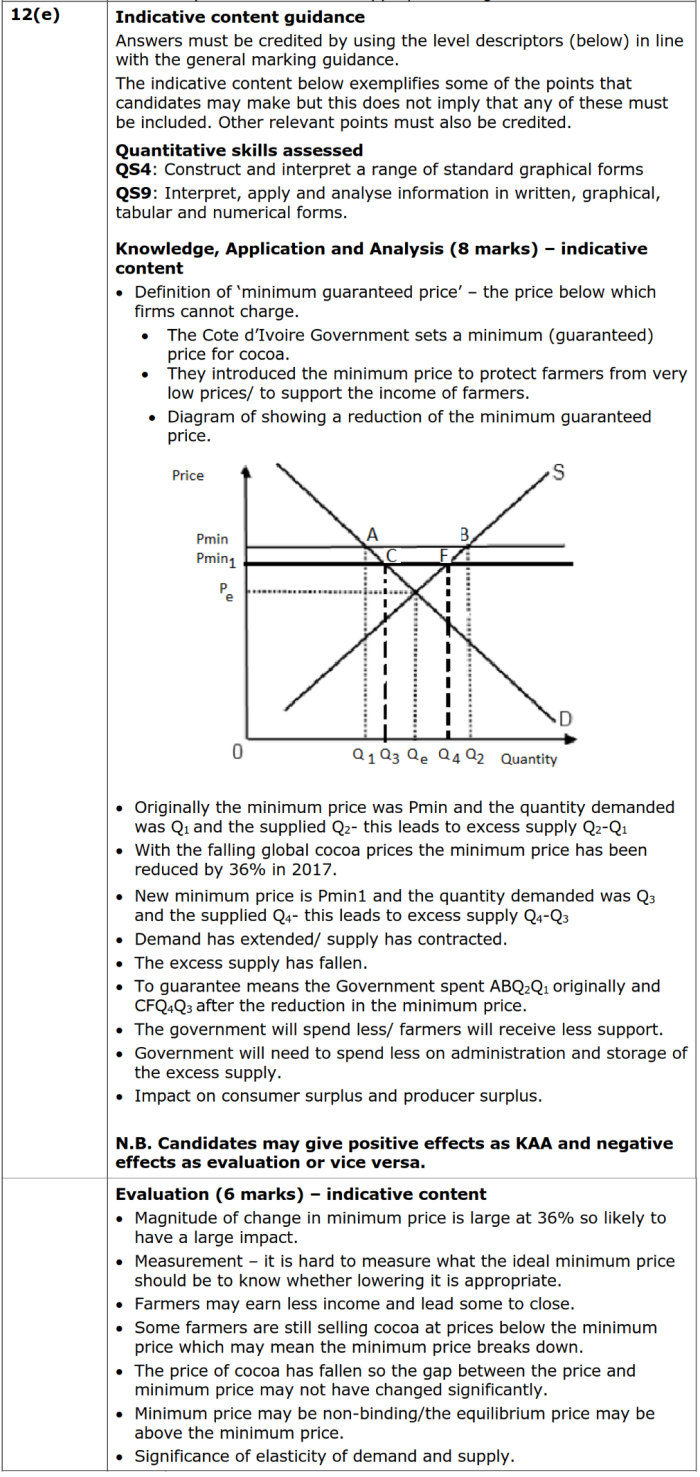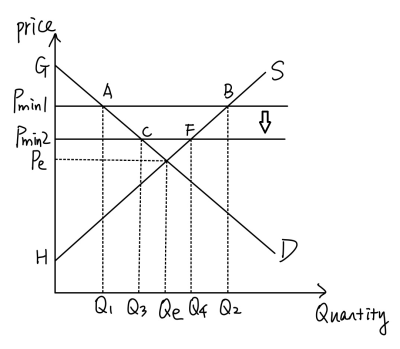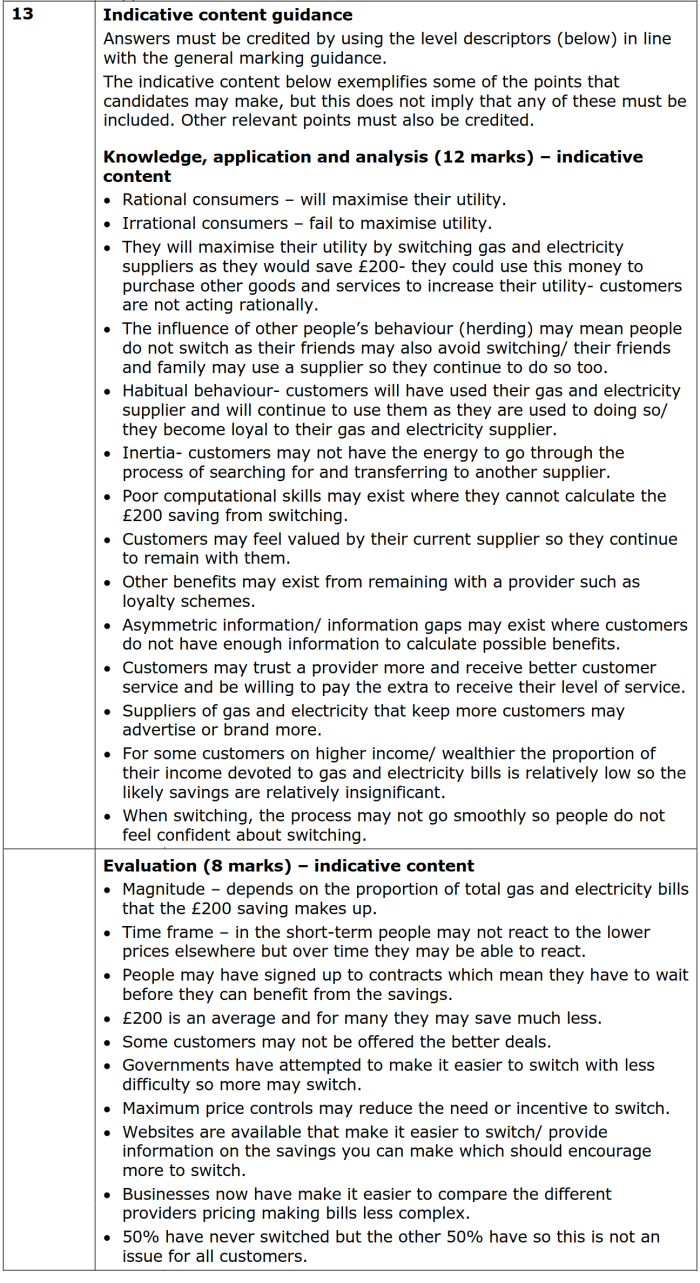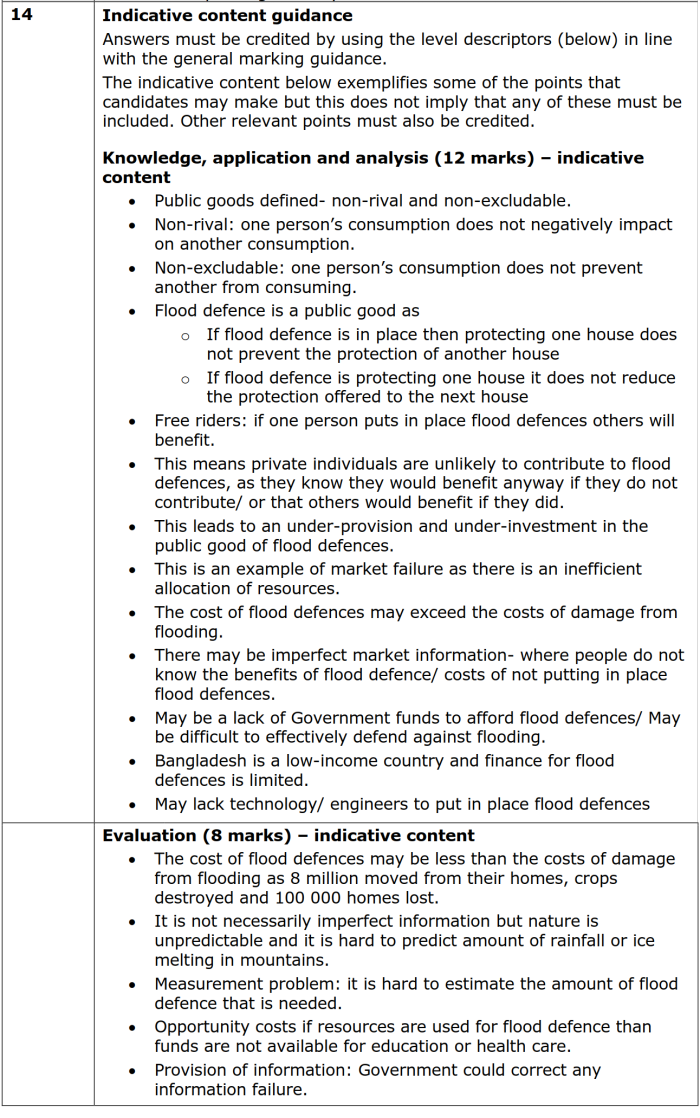“WEC11 01 que 20190109”的版本间的差异
(→12(e)) |
(→12(b)) |
||
| (未显示同一用户的7个中间版本) | |||
| 第97行: | 第97行: | ||
| align="right"|'''答案''' || || <big><big>''' D'''</big></big> | | align="right"|'''答案''' || || <big><big>''' D'''</big></big> | ||
|- | |- | ||
| align="right"|'''难度''' || || {{Background color|# | | align="right"|'''难度''' || || {{Background color|#FFC20E|''' 中等 '''}} | ||
|- | |- | ||
| align="right" valign="top"|'''考察知识点''' || || YED在具体情境下的解读 | | align="right" valign="top"|'''考察知识点''' || || YED在具体情境下的解读 | ||
| 第196行: | 第196行: | ||
| align="right" valign="top" |'''参考例文'''|| || style="background: #F0FFF0"| <blockquote><span style="font-size:20px"><span style="font-family:Times New Roman,楷体"> | | align="right" valign="top" |'''参考例文'''|| || style="background: #F0FFF0"| <blockquote><span style="font-size:20px"><span style="font-family:Times New Roman,楷体"> | ||
{{color|red|'''(材料运用→)'''}}(填表格,每个价格处的new quantity demanded等于original quantity demanded加上100) | {{color|red|'''(材料运用→)'''}}(填表格,每个价格处的new quantity demanded等于original quantity demanded加上100) | ||
{{color|red|'''(概念→)'''}}Market equilibrium occurs where quantity demanded and supplied are the same. {{color|red|'''(分析与计算→)'''}}According to the table, when the price is | {{color|red|'''(概念→)'''}}Market equilibrium occurs where quantity demanded and quantity supplied are the same. {{color|red|'''(分析与计算→)'''}}According to the table, when the price is ¥13, new quantity demanded and quantity supplied are both 500. Therefore, the equilibrium price is ¥13. | ||
</span></span></blockquote> | </span></span></blockquote> | ||
|- | |- | ||
| 第202行: | 第202行: | ||
|} | |} | ||
<br/> | <br/> | ||
===11=== | ===11=== | ||
{| | {| | ||
| 第235行: | 第236行: | ||
|-valign="top" <span style="font-size:30px"><span style="font-family:Arial,黑体"> | |-valign="top" <span style="font-size:30px"><span style="font-family:Arial,黑体"> | ||
|'''The market for cocoa'''<br/><br/> | |'''The market for cocoa'''<br/><br/> | ||
Extract A - The price of cocoa falls<br/><br/> | '''Extract A - The price of cocoa falls'''<br/><br/> | ||
Cocoa bean prices were high during 2015 and much of 2016 reflecting increased demand and decreased supply. For example, in 2016, consumption of cocoa exceeded production by 197 000 tonnes.<br/><br/> | Cocoa bean prices were high during 2015 and much of 2016 reflecting increased demand and decreased supply. For example, in 2016, consumption of cocoa exceeded production by 197 000 tonnes.<br/><br/> | ||
However, in 2017, production in the Côte d’Ivoire rose from 1.45 million tonnes to 1.93 million tonnes. The Côte d’Ivoire’s output increased after many new cocoa trees matured. Good cocoa harvests during 2017 led to stocks being 27.3% higher than in 2016. In April 2017, cocoa bean prices fell below $2 000 per tonne.<br/><br/> | However, in 2017, production in the Côte d’Ivoire rose from 1.45 million tonnes to 1.93 million tonnes. The Côte d’Ivoire’s output increased after many new cocoa trees matured. Good cocoa harvests during 2017 led to stocks being 27.3% higher than in 2016. In April 2017, cocoa bean prices fell below $2 000 per tonne.<br/><br/> | ||
Cocoa trees take four to five years to mature and produce cocoa pods. Cocoa trees grow best in regions near the equator. This means very few countries can successfully grow the crop.<br/><br/> | Cocoa trees take four to five years to mature and produce cocoa pods. Cocoa trees grow best in regions near the equator. This means very few countries can successfully grow the crop.<br/><br/> | ||
In contrast, the prices of substitutes for cocoa such as tea and coffee increased during 2017.<br/><br/> | In contrast, the prices of substitutes for cocoa such as tea and coffee increased during 2017.<br/><br/> | ||
<br/> | <br/> | ||
Extract B – Cocoa production can damage the environment<br/><br/> | '''Extract B – Cocoa production can damage the environment'''<br/><br/> | ||
Poor management of land used to produce cocoa means rainforest has to be destroyed so new plantations can be started. Soil erosion, caused by growing too much cocoa, makes the land less fertile and reduces crop yield. To increase production, some farmers have started to use fertilisers which cause river pollution.<br/><br/> | Poor management of land used to produce cocoa means rainforest has to be destroyed so new plantations can be started. Soil erosion, caused by growing too much cocoa, makes the land less fertile and reduces crop yield. To increase production, some farmers have started to use fertilisers which cause river pollution.<br/><br/> | ||
Farmers should be removing old cocoa trees and allowing the land to recover. Many cannot afford to do this because they need to earn revenue until the replacement trees grow. The continued use of older trees results in lower yields. Consequently farmers seek new land by destroying rainforests. In Indonesia the amount of land that is rainforest has fallen from 30% to closer to 15%. This has a significant negative impact on biodiversity.<br/><br/> | Farmers should be removing old cocoa trees and allowing the land to recover. Many cannot afford to do this because they need to earn revenue until the replacement trees grow. The continued use of older trees results in lower yields. Consequently farmers seek new land by destroying rainforests. In Indonesia the amount of land that is rainforest has fallen from 30% to closer to 15%. This has a significant negative impact on biodiversity.<br/><br/> | ||
However, the Rainforest Alliance trains cocoa farmers on how to manage their trees to avoid environmental damage. Between 2009 to 2015 the amount of cocoa produced by Rainforest Alliance farms increased from 2% to 16%.<br/><br/> | However, the Rainforest Alliance trains cocoa farmers on how to manage their trees to avoid environmental damage. Between 2009 to 2015 the amount of cocoa produced by Rainforest Alliance farms increased from 2% to 16%.<br/><br/> | ||
<br/> | <br/> | ||
Extract C – Minimum price scheme in the Côte d’Ivoire<br/><br/> | '''Extract C – Minimum price scheme in the Côte d’Ivoire'''<br/><br/> | ||
The Côte d’Ivoire Government sets a minimum (guaranteed) price for cocoa. In 2017, it reduced the minimum price by 36% to cut government spending and reduce cocoa stocks. However, some farmers still sell cocoa at prices below the minimum price because they can receive payments more quickly than from the Government. | The Côte d’Ivoire Government sets a minimum (guaranteed) price for cocoa. In 2017, it reduced the minimum price by 36% to cut government spending and reduce cocoa stocks. However, some farmers still sell cocoa at prices below the minimum price because they can receive payments more quickly than from the Government. | ||
||'''可可市场'''<br/><br/> | ||'''可可市场'''<br/><br/> | ||
| 第308行: | 第308行: | ||
{{color|red|'''(概念→)'''}}Price elasticity of supply means the responsiveness of quantity supplied to a change in the price. Inelastic supply is where a change in price will see a smaller percentage change in quantity supplied.<br/> | {{color|red|'''(概念→)'''}}Price elasticity of supply means the responsiveness of quantity supplied to a change in the price. Inelastic supply is where a change in price will see a smaller percentage change in quantity supplied.<br/> | ||
<br/> | <br/> | ||
{{color|red|'''(指出影响因素→)'''}}Time is one factor to influence PES. {{color|red|'''(引用指定文段内容→)'''}}According to Extract A, cocoa trees take four to five years to mature and produce cocoa pods. {{color|red|'''(紧扣概念进行说明分析→)'''}}When price of cocoa increases, the | {{color|red|'''(指出影响因素→)'''}}Time is one factor to influence PES. {{color|red|'''(引用指定文段内容→)'''}}According to Extract A, cocoa trees take four to five years to mature and produce cocoa pods. {{color|red|'''(紧扣概念进行说明分析→)'''}}When price of cocoa increases, the quantity supplied of cocoa is difficult to increase as quickly as the price because cocoa needs time to mature. Therefore, PES of cocoa would be inelastic. | ||
</span></span></blockquote> | </span></span></blockquote> | ||
|- | |- | ||
| 第314行: | 第314行: | ||
|} | |} | ||
<br/> | <br/> | ||
====12(c)==== | ====12(c)==== | ||
{| | {| | ||
| 第393行: | 第394行: | ||
|- | |- | ||
| align="right" valign="top" |'''文字版备查'''|| ||<small>With reference to Extract C, discuss the likely effects of the reduction in the minimum (guaranteed) price for cocoa. Illustrate your answer with an appropriate diagram.</small> | | align="right" valign="top" |'''文字版备查'''|| ||<small>With reference to Extract C, discuss the likely effects of the reduction in the minimum (guaranteed) price for cocoa. Illustrate your answer with an appropriate diagram.</small> | ||
|} | |||
<br/> | |||
===13=== | |||
{| | |||
|- | |||
| align="right" valign="top" |'''题目'''|| || style="background: #FAF0E6"| [[File:EdxAL_2019_01_P1_13_1.png|700px]] | |||
|- | |||
| align="right" |'''题目类型'''|| || '''解释原因题''' | |||
|- | |||
| align="right" valign="top" |'''难度''' || || {{Background color|red|{{color|white|''' 困难 '''}}}} | |||
|- | |||
| align="right" valign="top" |'''考察知识点'''|| || 人们出现irrational behaviour的原因 | |||
|- | |||
| align="right" valign="top" width="100px" |'''解答要点'''|| || ● 写出irrational behaviour的定义,给出至少4个可能的原因并进行分析和评价。 | |||
|- | |||
| align="right" valign="top" |'''官方答案'''|| || style="background: #d3d3d3"| [[File:EdxAL_2019_01_P1_13_2.png|700px]] | |||
|- | |||
| align="right" valign="top" |'''参考例文'''|| || style="background: #F0FFF0"| <blockquote><span style="font-size:20px"><span style="font-family:Times New Roman,楷体"> | |||
{{color|red|'''(概念→)'''}}Irrational behaviours occur when consumers fail to maximise their utilities. {{color|red|'''(背景材料引用→)'''}}50% of gas and electricity consumers in the UK have never switched energy suppliers, although switching suppliers could save up to £200 each per year. {{color|red|'''(结合概念分析→)'''}}It is an example of irrational behaviours because people could use these money to buy more goods and increase their living standards if they changed their suppliers.<br/> | |||
<br/> | |||
{{color|red|'''(指出原因1→)'''}}One reason of irrational behaviours is the influence of other people's behaviour. {{color|red|'''(解释分析→)'''}}If their relatives and friends do not change energy suppliers, consumers may not change their energy suppliers as well. They may just want to keep the same choices with people around and not be considered as strange people. {{color|red|'''(评价→)'''}}However, £200 is a large amount, which can attract many people to change their choices. There are also another 50% of consumers who have changed their mind in the extract.<br/> | |||
<br/> | |||
{{color|red|'''(指出原因2→)'''}}Another reason is the habitual behaviour. {{color|red|'''(解释分析→)'''}}Some consumers have been accustomed to their present energy suppliers and do not want to change a new one, because they may spend more time to know basic operations of new suppliers. {{color|red|'''(评价→)'''}}However, it depends on the time frame. After a long time, more consumers will accept new suppliers and are glad to use them.<br/> | |||
<br/> | |||
{{color|red|'''(指出原因3→)'''}}The third reason is information gaps. {{color|red|'''(解释分析→)'''}}Some consumers may not have enough information to calculate possible benefits of changing energy suppliers. They could underestimate money they could save, or they may even do not know they can save money if they change to new suppliers. {{color|red|'''(评价→)'''}}However, websites are available to make it easier for consumers to search information. The information gaps will become smaller, which may reduce irrational behaviours of consumers.<br/> | |||
<br/> | |||
{{color|red|'''(指出原因4→)'''}}In addition, inertia can also cause irration behaviours. {{color|red|'''(解释分析→)'''}}People may spend a lot of time to go through the process of searching for and transferring to another supplier. Therefore, they prefer to use present energy suppliers rather than transfer to a new one. {{color|red|'''(评价→)'''}}However, some people may have signed up to contracts which mean they have to wait before their contracts end up. So they cannot change their choices now.<br/> | |||
<br/> | |||
{{color|red|'''(结合问题总结上文观点→)'''}}In summary, reasons of irrational behaviours include herding behaviours, habitual behaviours, information gaps and inertia. | |||
</span></span></blockquote> | |||
|- | |||
| align="right" valign="top" |'''文字版备查'''|| ||<small>In 2016 it was reported that 50% of gas and electricity consumers in the UK have never switched energy suppliers. It is claimed that those consumers who did switch suppliers saved up to £200 each per year. Evaluate the reasons why many consumers do not switch energy suppliers.</small> | |||
|} | |||
<br/> | |||
===14=== | |||
{| | |||
|- | |||
| align="right" valign="top" |'''题目'''|| || style="background: #FAF0E6"| [[File:EdxAL_2019_01_P1_14_1.png|700px]] | |||
|- | |||
| align="right" |'''题目类型'''|| || '''解释原因题''' | |||
|- | |||
| align="right" valign="top" |'''难度''' || || {{Background color|red|{{color|white|''' 困难 '''}}}} | |||
|- | |||
| align="right" valign="top" |'''考察知识点'''|| || public goods相关知识 | |||
|- | |||
| align="right" valign="top" width="100px" |'''解答要点'''|| || ● 主要针对public good导致私企投资不足的观点进行分析,此外再结合生活知识指出3个其他导致投资不足的原因。 | |||
|- | |||
| align="right" valign="top" |'''官方答案'''|| || style="background: #d3d3d3"| [[File:EdxAL_2019_01_P1_14_2.png|700px]] | |||
|- | |||
| align="right" valign="top" |'''参考例文'''|| || style="background: #F0FFF0"| <blockquote><span style="font-size:20px"><span style="font-family:Times New Roman,楷体"> | |||
{{color|red|'''(指出观点1→)'''}}One reason of under-investment is the existance of public good. {{color|red|'''(概念与解释分析→)'''}}A public good is the good which is non-excludable and non-rival. Non-excludability means one person's consumption does not prevent another from consuming. If flood defence is in place then protecting one house does not prevent the protection of another house, so flood defences meet the characteristic of non-excludability. Non-rival means one person's consumption does not negatively impact on another consumption. If flood defence is protecting one house it does not reduce the protection offered to the next house, so flood defences meet the characteristic of non-rivalry. Therefore, flood defence is an example of public good.<br/> | |||
<br/> | |||
{{color|red|'''(概念→)'''}}Free rider problem occurs normally for public goods. {{color|red|'''(解释分析→)'''}}If one person puts in place flood defences, others will benefit without paying any costs. It means private individuals are unlikely to contribute to flood defences, as they know they cannot make profits from building flood defences. Hence, it leads to an under-provision and under-investment in the public good of flood defences.<br/> | |||
<br/> | |||
{{color|red|'''(评价→)'''}}However, the government can build flood defences directly using its government revenue. It will correct the under-investment by private firms and reduce the negative impact by this market failure.<br/> | |||
<br/> | |||
{{color|red|'''(指出观点2→)'''}}Another reason is information gaps. {{color|red|'''(解释分析→)'''}}People may not have enough information to estimate benefits of building flood defences. Benefits are under-estimated, so firms do not want to invest much money for flood defences. {{color|red|'''(评价→)'''}}However, websites are available for people to search information about flood defences. The information gaps will become smaller and the negative impact can decrease as well.<br/> | |||
<br/> | |||
{{color|red|'''(指出观点3→)'''}}The third reason is a lack of funds. {{color|red|'''(解释分析→)'''}}The government may not have enough money to build flood defences as there are budget deficits in recent years. The government may aim to develop healthcare and education at first, so there are not enough money for infrastructure. {{color|red|'''(评价→)'''}}However, it depends on the amount of money for flood defences. If the amount is not too much, the government may slove the fund problem by borrowing.<br/> | |||
<br/> | |||
{{color|red|'''(指出观点4→)'''}}In addition, a lack of technology can be another reason. {{color|red|'''(解释分析→)'''}}As Bangladesh is a developing country, it may not have enough technology, machines or skilled engineers to build flood defences. Therefore, the government may have under-investment for this project. {{color|red|'''(评价→)'''}}However, the government can invite engineers from abroad to help domestic citizens to build this project. The negative impact caused by lacking technology could reduce.<br/> | |||
<br/> | |||
{{color|red|'''(结合问题总结上文观点→)'''}}In summary, the reasons of under-investment include the existance of public goods, information gaps, a lack of funds and a lack of technology. | |||
</span></span></blockquote> | |||
|- | |||
| align="right" valign="top" |'''文字版备查'''|| ||<small>In 2017 floods in Bangladesh resulted in 8 million people having to move from their homes. 100 000 houses were destroyed and many crops were lost. The Institute of Water and Flood Management claim that there had been an under-investment in flood defences. Evaluate reasons for this under-investment in flood defences. Make reference to public goods in your answer.</small> | |||
|} | |} | ||
<br/> | <br/> | ||
2023年2月12日 (日) 12:02的最新版本
单题搜索方法:右上角搜索中输入该题中的部分文字,点击搜索后进入相关页面,然后使用ctrl+F5(或其他按键组合调出搜索框),再次搜索该题干文字,直接定位到题目。
整卷下载
- 试卷请点击此处 ⇒ 【2019 冬季 U1】
- 答案请点击此处 ⇒ 【2019 冬季 U1 mark scheme】
题目解答
1
2
3
4
5
| 题目 | 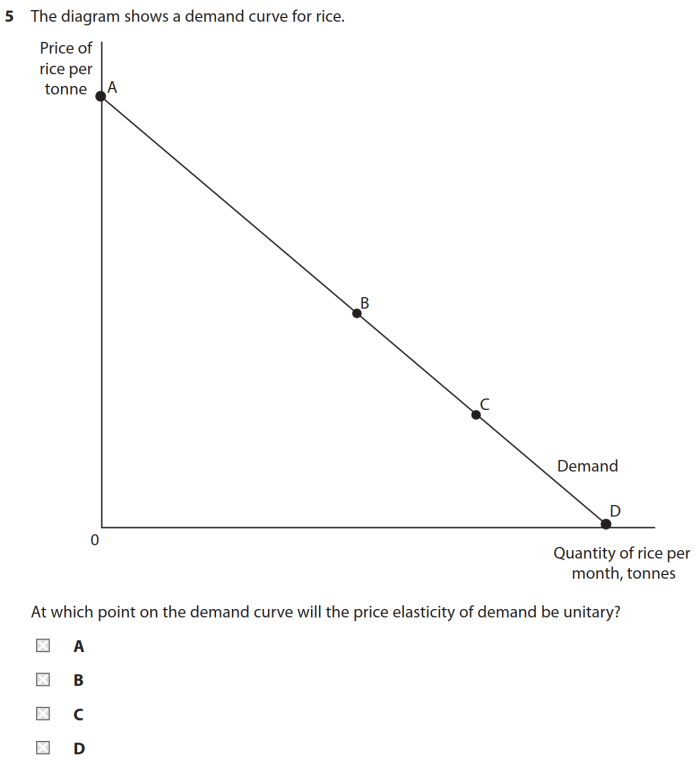
| |
| 答案 | B | |
| 难度 | 容易 | |
| 考察知识点 | Demand线上各点的PED值 | |
| 解答要点 | ● 单位弹性位于D线的中点位置,因此B选项正确。 | |
| 文字版备查 | The diagram shows a demand curve for rice. At which point on the demand curve will the price elasticity of demand be unitary? |
6
7
8
9
10
11
12
文章材料-中英对照
| 原文 | 参考译文(谷歌机翻) |
|---|---|
| The market for cocoa Extract A - The price of cocoa falls |
可可市场 摘录A - 可可价格下跌 |
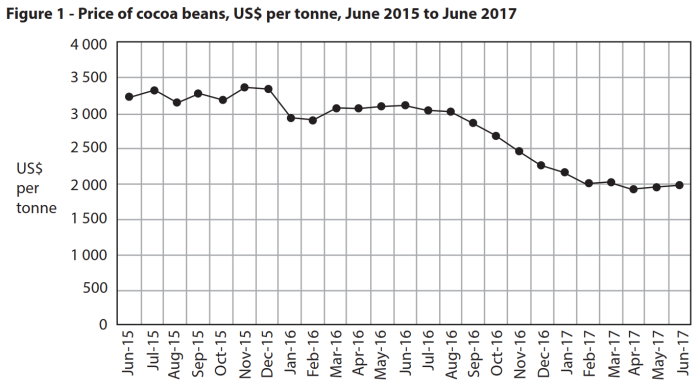
12(a)
12(b)
12(c)
12(d)
12(e)
13
14
